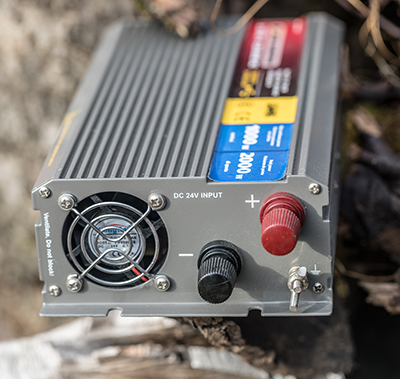
Mobile offices need power, and if you read almost any blog about powering a mobile office, you will quickly notice the value of auxiliary batteries. Read on below to get familiar with the topic.
Terminology
Chassis Bay: The battery that came with your car, the one that powers the engine and the windshield wipers and the electronics in your car.
Auxiliary Battery: A secondary battery you can add to your vehicle to power additional electronics.
General Background
Auxiliary batteries are used because your regular car battery that powers your ignition, lights, and electronics just can’t cut it.
When you turn your ignition on, your car battery spends a ton of energy pushing the engine into motion. It has to release all this energy in a quick amount of time, and it needs a certain type of battery to do that. Car engine batteries, otherwise known as chassis batteries, are perfect for that purpose. Chassis batteries take a lot of time to fill up and an extremely short amount of time to deplete.
Bob Hanks, of Fleet Electric, explains it with an analogy: cups. Say you’re filling up a cup from a slow faucet. Once it’s all filled, you can simply turn the cup over and have all the water fall to the floor in a single second. The same is true for the battery in your car. It fills up slowly but is drained significantly in the short time it takes to turn your engine on.
Naturally, it’s pretty easy to guess that these quick-discharging batteries are not very compatible with the slow and steady flow of power we need for powering a mobile office.
That’s where the auxiliary battery comes in.
Auxiliary batteries are an additional battery you connect to your engine, that, depending on the model, discharge electricity at a steady rate. There is benefit to this as well, in that you don’t have to worry about draining the battery so much that you need a jumpstart. If you have an auxiliary battery, and you drain it completely, your car’s original battery will stay full, and ready to start the engine (that is, of course, if you use the right connection, which we’ll get into later).
Which Auxiliary Battery Should I Get?
There are three main auxiliary battery types: lead, AGM, and lithium. All three are very different and suited for different circumstances, so be sure to read and think about which one suits your situation best.
Lead
Lead batteries are the most low-cost option in terms of auxiliary batteries, but it

may not be the best option for you just based on that fact alone.
Lead batteries require regular maintenance, something that AGM and lithium batteries don’t. Lead batteries are also heavy, especially when compared to lithium batteries.
On the bright side, lead batteries can almost always be situated in your engine compartment, which lithium batteries can never do, and AGM batteries sometimes cannot.
AGM
AGM stands for Absorbent Glass Mat. They can withstand higher electrical demands then Lead batteries, and can deep cycle, depending on the model.
[Deep cycling means that a battery can be drained to nearly the dregs and suffer minimal damage relative to other batteries].
Lithium
Lithium batteries are currently the cream of the crop for auxiliary batteries. They are more expensive than other batteries, but also have many extra benefits that other batteries lack.
First off, lithium batteries are very light and doesn’t need maintenance, which are both nice benefits. But the best benefit of a lithium battery is its long life. It can be charged and recharged many more times than its competitors and can deep cycle more intensely with hardly any damage. Lithium batteries also self-discharge much less than other batteries.
Even though there are many benefits to a lithium battery, they can’t be mounted in the engine compartment, which can be a downside.
What Connection Should I Have From My Auxiliary to Chassis Battery?
When buying an auxiliary battery, you also need to think about what connection you’d like it to have with your car’s original battery.
There are a few different options, which we’ll go over below. Think about your car and what you think would be the best fit for it.
Hard Wired
A hard-wire connection is the most basic and cheap option you can get for wiring your auxiliary battery, but as Bob Hanks says, “you get what you pay for”.
A hard-wired connection is not recommended in virtually all situations, and particularly not for a mobile office.
The problem with hard wire connections is that it treats the auxiliary battery and the original battery as one unit. This is a bad set up because it discharges equally from each battery. This means that it’s very likely you will drain your first battery so much that you won’t have enough power for the ignition.
Solenoid
Solenoid connections are low-cost as well as quite different than hard wired connections. First off, they need a ton of energy to begin operating. This can create a lot of heat, which is not always great for the battery or for your vehicle.
When the ignition is turned off, the two batteries are treated as separate. However, while the vehicle is running, they are treated as one battery, and filled up at equal rates.
There is also a high voltage drop associated with this product.
There is also a risk to any sensitive electronics connected to your car. This is because when being turned off, the solenoid releases a high-voltage spike, which can damage your electronics. However, a shunting diode should help mitigate this.
Isolator
Battery isolators contain diodes that let the alternator charge the two batteries, but while also blocking the flow of currents between the two. The lack of flow between the two batteries makes it virtually impossible for the chassis battery to get power from the auxiliary battery, as well as virtually impossible for the auxiliary battery to get power from the chassis battery. Each battery can only be charged by the alternator, which charges while the car is running. An isolator watches your voltage and makes sure that when your car needs energy, it draws power from the strongest battery.
Isolators don’t draw power from multiple batteries at once, and this is a good thing, because if you draw from multiple batteries, it’s easy to drain your batteries too much and become unable to start your vehicle. This is the problem seen with hard-wired connections, which we talked about earlier.
Like some of the other methods that we’ve mentioned, the isolator’s voltage drops a large amount. This has some consequences, from something as simple as an undercharged auxiliary battery, to setting off fault codes from your car’s computer.
Separators
A separator monitors the voltage in your batteries, and strategically decides when to isolate each battery, and when to connect them.
When your engine is running, your separator will often connect each battery so that they can both be charged by your vehicle. However, if both of your batteries need an excessive amount of power that the alternator can’t provide, it will prioritize your chassis battery so that you’re still able to successfully turn your ignition and start your car.
Isolator vs Separator
An isolator’s main mission is to make sure your auxiliary battery is the only battery getting drained when your car is off. That way, you can use power without fear that you won’t be able to start your car afterwards.
Separators do that and more. Isolators can only run the current of electricity one way, but separators are bidirectional. A separator’s main mission is to make sure the multiple batteries do not overwhelm your vehicle’s electrical charging system. Plus, some separators can also help start your car when your chassis battery is low by engaging your auxiliary battery to help provide a boost.
Another thing to note is that separators do drain a bit of energy from your auxiliary battery, unlike isolators. Also, isolators are cheaper than separators.
Battery Separator (Solenoid) vs Auxiliary Battery Separator (Electronic)
Now that we’ve talked about the differences between isolators and separators, let’s talk about the different types of separators themselves.

The two types of separators we’ll be talking about today are solenoid and electronic separators. The main thing to know about solenoids is that their coil has a minimum amount of voltage needed to work, which may become a problem if you are having trouble starting your car. They also have a bit of a voltage spike, but its usually mitigated through the electronics.
This doesn’t happen with an electronic separator. The electronic separator is the solenoid’s cool older brother. All the good things about solenoids? The electronic separator has them too, but with less drawbacks. They have a lower threshold for voltage than the solenoid, and most even have a current limiting feature, so they can shut down a fuse for a little while if necessary.
Optimizer
The battery optimizer is where we’re currently at in terms of cutting-edge battery management technology. It’s kind of like an electronic separator, but better. It has all the capabilities of an electronic separator, but also can disconnect the auxiliary battery through a “Low Voltage-Time Out” circuit with its additional third terminal.
The optimizer accesses every battery powered device and battery, then tries to strategically protect the auxiliary battery from being drained to the very bottom.
Interface
Although not for sale yet, battery interfaces are expected to become very popular in the future. Still under development, battery interfaces have the potential to become an extremely helpful tool for battery management, and we are excited to see where they will go.

Conclusion
Auxiliary batteries and their connections can be a difficult topic for newcomers, but we hope that this article helped shed a little light on the details about them, and how to decide which ones are good for you and your mobile office.
To read more about creating your perfect mobile office, check out our other blogs below!
Sources:
“Absorbent Glass Mat (AGM) Car Battery: Autobatteries.com: Clarios.” Autobatteries.com, Clarios, Absorbent Glass Mat (AGM) | Autobatteries.com
Fleet Electric. METHODS OF CONNECTING CHASSIS AND AUXILIARY BATTERIES, Fleet Electric, Auburn, MA.
Lev, Sarah. “Bob Hanks Interview.” 5 Aug. 2021
REDARC Team. “Which Auxiliary Battery Do I Need?” The Power of REDARC, REDARC, 25 Nov. 2018, https://redarcelectronics.com/blogs/blog/which-auxiliary-battery-do-i-need.
Shepard, Jeff. What's the Difference between Battery Isolators and Battery Separators? Battery Power Tips, 25 Aug. 2021, https://www.batterypowertips.com/whats-the-difference-between-battery-isolators-and-battery-separators/.
“What Is a Battery Isolator, Diode, or Solinoid?” Sun Power RV - Go Power Solar Panels, Portable Solar Power for RV's and Motorhomes., Sun Power RV, https://www.sunpowerrv.com/battery-isolators.














